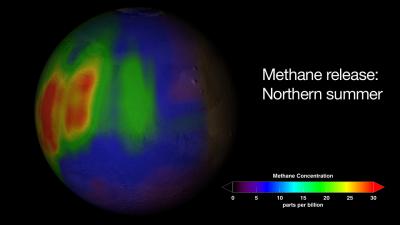Wait, how can a bunch of smart people from NASA not know which?
It's because methane, four atoms of hydrogen bound to a carbon atom, is the main component of natural gas on Earth and is released by organisms as they (and we) digest nutrients but is also created in purely geological processes, like oxidation of iron.
"Right now, we do not have enough information to tell whether biology or geology -- or both -- is producing the methane on Mars," Michael Mumma of NASA's Goddard Space Flight Center in Greenbelt, Md. "But it does tell us the planet is still alive, at least in a geologic sense. It is as if Mars is challenging us, saying, 'hey, find out what this means.' "
The team found methane in the Martian atmosphere by carefully observing the planet throughout several Mars years with NASA's Infrared Telescope Facility and the W.M. Keck telescope, both at Mauna Kea, Hawaii. The team used spectrometers on the telescopes to spread the light into its component colors, as a prism separates white light into a rainbow. The team detected three spectral features called absorption lines that together are a definitive signature of methane.

This image shows concentrations of Methane discovered on Mars. Credit: NASA
"Methane is quickly destroyed in the Martian atmosphere in a variety of ways, so our discovery of substantial plumes of methane in the northern hemisphere of Mars in 2003 indicates some ongoing process is releasing the gas," said Mumma, lead author of a paper describing the research in Science Express. "At northern mid-summer, methane is released at a rate comparable to that of the massive hydrocarbon seep at Coal Oil Point in Santa Barbara, Calif."
If microscopic Martian life is producing the methane, it likely resides far below the surface where it is warm enough for liquid water to exist. Liquid water is necessary for all known forms of life, as are energy sources and a supply of carbon.
"On Earth, microorganisms thrive about 1.2 to 1.9 miles beneath the Witwatersrand basin of South Africa, where natural radioactivity splits water molecules into molecular hydrogen and oxygen," Mumma said. "The organisms use the hydrogen for energy. It might be possible for similar organisms to survive for billions of years below the permafrost layer on Mars, where water is liquid, radiation supplies energy, and carbon dioxide provides carbon. Gases, like methane, accumulated in such underground zones might be released into the atmosphere if pores or fissures open during the warm seasons, connecting the deep zones to the atmosphere at crater walls or canyons."
It is possible a geologic process produced the Martian methane, either now or eons ago. On Earth, the conversion of iron oxide into the serpentine group of minerals creates methane, and on Mars this process could proceed using water, carbon dioxide and the planet's internal heat. Although there is no evidence of active volcanism on Mars today, ancient methane trapped in ice cages called clathrates might be released now.
"We observed and mapped multiple plumes of methane on Mars, one of which released about 19,000 metric tons of methane," said co-author Geronimo Villanueva of the Catholic University of America in Washington. "The plumes were emitted during the warmer seasons, spring and summer, perhaps because ice blocking cracks and fissures vaporized, allowing methane to seep into the Martian air."
According to the team, the plumes were seen over areas that show evidence of ancient ground ice or flowing water. Plumes appeared over the Martian northern hemisphere regions such as east of Arabia Terra, the Nili Fossae region, and the south-east quadrant of Syrtis Major, an ancient volcano about 745 miles across.
One method to test whether life produced this methane is by measuring isotope ratios. Isotopes of an element have slightly different chemical properties, and life prefers to use the lighter isotopes. A chemical called deuterium is a heavier version of hydrogen. Methane and water released on Mars should show distinctive ratios for isotopes of hydrogen and carbon if life was responsible for methane production. It will take future missions, like NASA's Mars Science Laboratory, to discover the origin of the Martian methane.
The research was funded by the Planetary Astronomy Program at NASA Headquarters in Washington and the Astrobiology Institute at NASA's Ames Research Center in Moffett Field, Calif. The University of Hawaii manages NASA's Infrared Telescope Facility.
Article: Michael J. Mumma, Geronimo L. Villaneuva, Robert E. Novak, Tilak Hewagama, Boncho P. Bonev, Michael A. DiSanti, Avi M. Mandel, Michael D. Smith, 'Strong Release of Methane on Mars in Northern Summer 2003', Science DOI: 10.1126/science.1165243





Comments